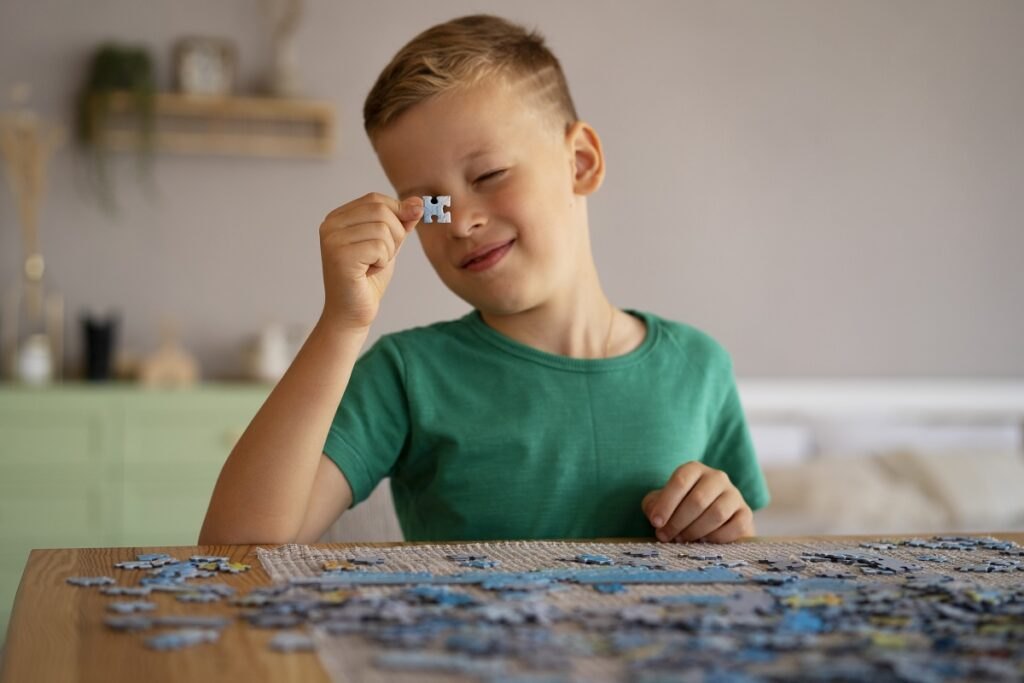Assembling puzzles is one of the most popular and beloved toys among children. But did you know that this simple and enjoyable activity has many benefits for your child’s development? In this article, we will explore the positive effects that assembling puzzles has for the youngest.
At what age does a child start assembling puzzles?
In reality, there is no definitive answer to this question, as each child develops at their own pace. However, general guidelines can be provided to help you determine if your child is ready to start assembling puzzles.
At around 1-2 years old, children begin to develop motor and manual skills. During this period, they may start to show interest in toys that require precise movements, such as blocks or simple puzzles. You can try introducing your child to simple puzzles with large pieces and a small number of elements. Children at this age often use a trial-and-error method, but it is through this that they learn and develop their skills.
At around 2-3 years old, most children have greater control over their movements and the ability to manipulate objects. They may start assembling puzzles with more pieces, although they will still prefer those with simple patterns and bright colors. This is a good time to introduce your child to puzzles featuring images of animals, vehicles, or characters from cartoons that interest them.
At around 3-4 years old, children begin to show greater ability to focus and think logically. They can assemble more advanced puzzles with a greater number of pieces and more complex patterns. At this age, they may be interested in assembling larger puzzles, such as those made up of 50 or more pieces. This is also a good time to develop the child’s observational and concentration skills.
At 4-5 years old, children become more independent and capable of assembling puzzles of greater difficulty. Their motor and cognitive skills are more developed, and their concentration and observational skills become stronger. Children at this age can enjoy assembling puzzles with a larger number of pieces, more advanced patterns, and various shapes.
As time goes on and the child develops, their puzzle-assembling skills will improve. They will become increasingly adept and precise in manipulating pieces, as well as in analyzing and solving puzzles. Some children by the age of 6-7 can handle difficult puzzles designed for older kids.
Benefits of Assembling Puzzles
First of all, assembling puzzles develops cognitive abilities and logical thinking skills in children. When little ones try to match different shapes and colors, their minds are stimulated to think and analyze. They have to consider different possibilities, plan, and predict how a given piece might fit into the rest of the puzzle. This is excellent training for their brains, which helps in developing skills of observation, concentration, and logical reasoning.
Secondly, assembling puzzles improves children’s motor and manipulative skills. Moving, rotating, and fitting pieces requires precision and dexterity of the hands. Children need to exercise their little fingers to fit the puzzle pieces into the right place. This develops their manual skills and hand-eye coordination and enhances motor precision. Additionally, assembling puzzles is a great exercise for the muscles of the hands, which can be particularly helpful for children in their graphomotor development.
Another benefit is developing patience and perseverance. Assembling puzzles is a time-consuming process that requires a lot of time and focus from children. Sometimes they may encounter difficulties when they can’t find a matching piece right away. However, gradually, piece by piece, they unravel the puzzle and notice progress. This teaches them patience, perseverance, and shows that it is worth the effort to achieve the intended goal.
Assembling puzzles also has a positive impact on developing children’s imagination and creativity. When children put together puzzle pieces, they create a picture or scene. This gives them the opportunity for creative thinking and self-expression. They can come up with their own stories and narrate them based on the assembled puzzle. It’s a great way to develop their imagination and spark creativity.
Equally important is the effect of assembling puzzles on building a sense of achievement and self-confidence in children. When little ones complete a puzzle, they experience immense satisfaction and pride in their accomplishments. This reinforces positive emotions and self-esteem. Each completed puzzle is a small success that builds self-confidence and encourages taking on new challenges.
Finally, assembling puzzles is an excellent opportunity to spend quality time together with siblings, friends, or parents. It is an activity that can be done together, sharing the joy of creating and achieving progress. Working on puzzles together strengthens bonds, teaches children cooperation and communication. It’s a wonderful opportunity to spend time together, talking, laughing, and developing relationships.
What puzzles should you choose for your child?
It is important to choose puzzles that are appropriate for your child’s age and skills. There are various types of puzzles available on the market, differing in the number of pieces, size, and themes. If your child is still small and just starting their adventure with puzzles, begin with simple puzzles that have larger pieces. Choose puzzles that have fewer pieces and simple patterns to make it easier for your child to fit them together.
- Puzzles with large pieces are ideal for small hands. They will give your child greater control over the puzzles and make them easier to manipulate. It is also worth paying attention to the durability of the puzzles.
- Choose models made from sturdy materials that will withstand intense play and repeated assembling.
- Another factor to consider is the theme of the puzzles. Choose puzzles with images that will interest your child. This could be a theme of animals, vehicles, characters from fairy tales, or favorite heroes. Assembling puzzles will become more attractive and motivating for your child.
- Additionally, it is also important to gradually increase the difficulty level of the puzzles. If your child is doing well with puzzles that have fewer pieces, you can gradually introduce puzzles with more pieces. This will allow your child to develop their skills and gradually raise the bar.
-
Assembling puzzles together: It is also worth choosing puzzles that can be assembled together with your child. This way, you can spend time together, talk, and learn together. Assembling puzzles can be a great opportunity to build bonds and communication between you and your child.
So you can see how many benefits come from assembling puzzles for children. When choosing the first puzzles for your child, it is worth considering their age, skills, and interests. Choose puzzles with large pieces and simple patterns that are suited to the child’s abilities. Remember that assembling puzzles is not only about learning but also about enjoyment and joy. Enjoy the moments spent together with puzzles and watch your child’s development!


